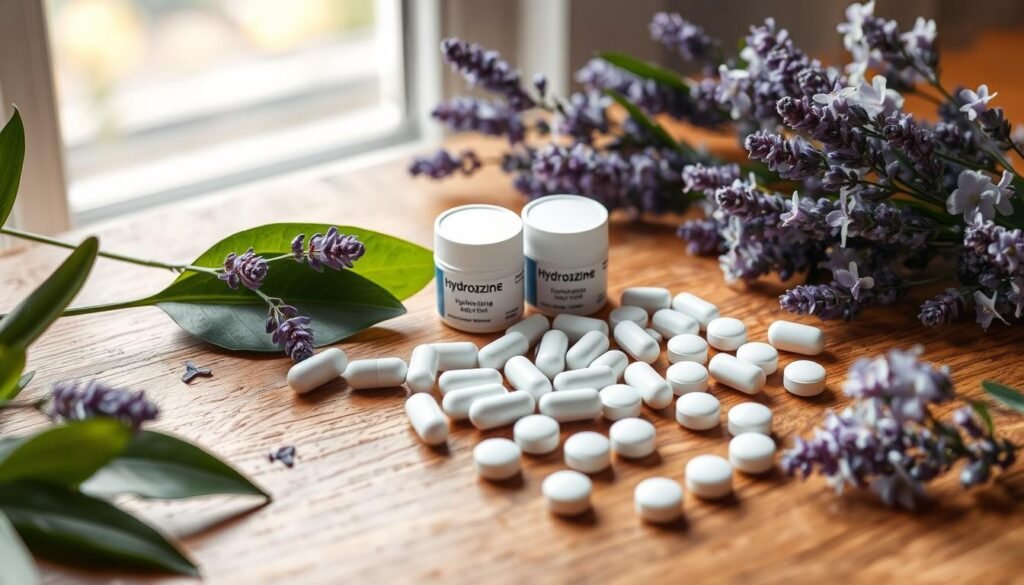Did you know that more than 30 percent of adults in the United States will experience an anxiety disorder at some point? This fact shows how common anxiety is, highlighting the need for effective treatments. Hydroxyzine, also known by the brand name Vistaril, is recognized for its role in Hydroxyzine and anxiety management. It’s an FDA-approved antihistamine for treating anxiety and can be used for various anxiety disorders, including generalized anxiety disorder (GAD) and panic attacks.
Hydroxyzine offers quick relief as a short-term treatment for anxiety symptoms. Since it’s non-habit forming, it’s a good choice for those wanting temporary assistance without the risks tied to some anxiety medications. We’ll take a closer look at the benefits of hydroxyzine in this article. You’ll learn about how it works, its effectiveness, and any side effects to consider. This will give you a better understanding of how hydroxyzine can help those with anxiety.
Key Takeaways
- Hydroxyzine is FDA-approved for treating anxiety disorders.
- About 30% of U.S. adults experience anxiety at some point in their lives.
- It is non-habit forming, making it a safer short-term option.
- Hydroxyzine may be effective for various anxiety-related conditions.
- It typically starts to work within 15 to 30 minutes of ingestion.
Introduction to Hydroxyzine
Hydroxyzine medication is widely used to treat health concerns for years. It works as an antihistamine to stop allergic reactions. It helps reduce itchiness from skin allergies in adults and children. This makes hydroxyzine for anxiety relief a key tool in mental health care.
Anxiety disorders impact millions in the United States. Learning about introduction to hydroxyzine shows its importance in treating these conditions. Studies prove hydroxyzine’s success in reducing anxiety, better than placebo treatments.
Hydroxyzine slows down the brain and blocks histamine, helping with anxiety. It can aid those dealing with anxiety because it eases symptoms quickly. People can feel its effects 30 minutes to an hour after taking it.
In conclusion, hydroxyzine is vital for managing anxiety. It offers antihistamine effects and helps people stay calm. Knowing how it works and how to use it is key for those needing anxiety relief.
What is Hydroxyzine?
Hydroxyzine is a medication known as an H1 antagonist. It is very important in many medical treatments. The hydroxyzine definition is about how it stops histamine. Histamine is a chemical that triggers allergic reactions. This medication is safe and approved by the FDA for use.
Hydroxyzine has several uses. It is often given to reduce anxiety and tension caused by emotional issues. It helps ease allergy symptoms like chronic hives and skin conditions. Hydroxyzine is also used to calm patients before surgery.
The drug comes in forms like hydrochloride (Atarax) and pamoate (Vistaril). Adults usually take 50 to 100 milligrams up to four times a day for anxiety. Children over six can take a total of 50 to 100 milligrams per day. It’s vital to follow the dosage a healthcare provider recommends to make sure the drug works well.
Hydroxyzine comes in tablets, syrup, and capsules, so patients can choose what they prefer. For more details on hydroxyzine types and dosages, click here.
Hydroxyzine and Anxiety Management
Hydroxyzine is a key medication for anxiety with a unique hydroxyzine mechanism. It interacts with the brain to calm you down, offering significant anxiety symptom relief. Knowing how it works can improve mental health treatment.
How Hydroxyzine Works in the Body
As an antihistamine, it blocks histamine in the body. This action reduces anxiety quickly. The calming effect begins within 30 to 60 minutes and lasts 4 to 6 hours. You might need a few doses a day for constant hydroxyzine and anxiety management.
Hydroxyzine’s Role in Managing Anxiety Symptoms
It helps with many anxiety types, like generalized anxiety disorder and panic disorder. It works by affecting serotonin levels, which boosts its relief capability. It works faster than many treatments, offering quick relief. Always talk to a doctor about adding hydroxyzine to your plan. Learn more at NAMI.

Its easy use and safety make hydroxyzine stand out for anxiety treatment. It’s different from drugs that can cause addiction. Always seek a doctor’s advice for safe treatment. For more details on how to use it, visit Mood Care Health.
Benefits of Using Hydroxyzine for Anxiety
Hydroxyzine helps those with anxiety in key ways. It quickly relieves acute anxiety symptoms. This makes it perfect for those who need fast help. It’s also not habit-forming, meaning no worries about getting addicted.
Short-Term Relief for Anxiety
Hydroxyzine provides quick relief in urgent situations. Symptoms often get better within a few hours. This is crucial for handling sudden anxiety, like panic attacks. It gives users control over their anxiety quickly.
Non-Habit Forming Nature
Hydroxyzine is safe for ongoing use and doesn’t lead to addiction. Unlike stronger drugs, it has a low dependence risk. This makes it a trusted choice for both patients and doctors.
| Feature | Hydroxyzine | Benzodiazepines |
|---|---|---|
| Type | Antihistamine | Anxiolytic |
| Dependency Risk | Low | High |
| Onset of Action | Hours | Hours |
| Common Side Effects | Dizziness, drowsiness | Drowsiness, lightheadedness |
| Usage Duration | Long-term, with monitoring | Short-term, risk of dependence |
Hydroxyzine vs. Other Anxiety Medications
There are many choices for anxiety relief, including hydroxyzine and benzodiazepines like Xanax. It’s important to know how they compare in terms of action and benefits.
Hydroxyzine, sold as Vistaril®, is an antihistamine. It helps reduce allergy symptoms and eases anxiety and tension. This medication is usually used for short-term treatment, up to four months. Benzodiazepines, like Xanax, work by calming the brain. They provide acute relief for anxiety and panic.
Hydroxyzine starts to work in 15 to 30 minutes, and its calming effect can last 4 to 6 hours. Xanax takes about an hour to work, with effects that can last up to 8 hours. People take hydroxyzine in doses of 25mg to 100mg four times a day. Xanax is prescribed in lower doses, up to three times a day.
Hydroxyzine vs benzodiazepines shows a clear difference in addiction risk. Xanax can lead to dependence and has withdrawal symptoms. Hydroxyzine, without these risks, has been useful for anxiety since the 1960s.
Both medicines can make you sleepy, but they have different side effects. Hydroxyzine might cause dry mouth, constipation, or headache. Xanax use can lead to misuse, dizziness, and serious withdrawal symptoms if stopped suddenly.
With 32% of adults facing anxiety at some point, finding the right treatment is key. Hydroxyzine offers short-term relief without the dependency risks of benzodiazepines.

Common Dosages of Hydroxyzine for Anxiety Relief
Knowing the right hydroxyzine dose for treating anxiety is key. Hydroxyzine is available in 10mg, 25mg, and 50mg oral tablets. This part talks about how much adults, kids, and seniors should take.
Dosage Guidelines for Adults
Adults usually take 50 to 100mg of hydroxyzine for anxiety, four times a day. The max daily dose is 400mg. For itching, 25mg three or four times a day works. Before medical procedures, a one-time dose of 50 to 100mg is used for calmness.
Dosage Considerations for Children and Older Adults
Kids under six should not take more than 50mg for anxiety or itching, spread out over the day. Older kids, from six years up, can have 50 to 100mg divided through the day. For making them calm before procedures, the dose is 0.6mg per kilogram of their weight.

| Patient Age | Indication | Typical Dosage | Maximum Daily Dosage |
|---|---|---|---|
| Adults | Anxiety | 50-100mg (4x daily) | 400mg |
| Adults | Itching | 25mg (3-4x daily) | 100mg |
| Children (under 6) | Anxiety & Itching | 50mg (divided doses) | 50mg |
| Children (6 and older) | Anxiety | 50-100mg (divided doses) | 100mg |
| Children | Sedation | 0.6mg/kg (single dose) | Varies |
Potential Side Effects of Hydroxyzine
Knowing the side effects of hydroxyzine is important for its safe use. It can cause mild to serious effects. It’s key to understand how it impacts different people.
Mild Side Effects
Common hydroxyzine side effects often include:
- Drowsiness
- Dry mouth
- Confusion
- Headache
- Dizziness
These mild side effects usually get better as your body gets used to the drug.
Serious Side Effects to Be Aware Of
Most people handle hydroxyzine well, but sometimes serious side effects happen. Be on the lookout for issues like:
- Allergic reactions with skin rash, itching, hives, and swelling in areas like the face or throat
- Changes in heart rhythm, like fast or uneven beats, feeling dizzy, or chest pain
- Problems breathing
- Hallucinations
It’s critical to tell a healthcare provider about these serious side effects. Older people may feel these effects more strongly.
Hydroxyzine is given to children over 2 years for certain conditions. But it’s important to watch for all side effects. Being aware of potential side effects helps manage medication safely.
| Side Effect Category | Examples | Severity |
|---|---|---|
| Mild Side Effects | Drowsiness, Dry Mouth, Confusion | Common |
| Serious Side Effects | Allergic Reactions, Hallucinations | Rare but Severe |
When to Consult with a Healthcare Provider
If you’re thinking about hydroxyzine for anxiety, talk to a healthcare provider first. It’s crucial to discuss your medical history, like any health issues or other medicines that might not mix well with hydroxyzine. Knowing your health situation helps make sure the medication works safely and effectively for you.
After starting hydroxyzine, keeping in touch with your healthcare provider is key. Regular check-ins help adjust your dose correctly and deal with any side effects quickly. Older adults might need extra care because they can be more sensitive to the medication.
Being honest about how you’re feeling and any treatment worries is really important. Your healthcare provider can guide you on managing anxiety and may change your treatment if needed. This kind of open talk ensures you get the care that fits you best.
Hydroxyzine and Mental Health
When adding hydroxyzine to an anxiety treatment plan, it’s essential to proceed with caution and get professional guidance. Knowing how this medication works makes it more effective and boosts mental health. Healthcare pros must oversee its use, tailoring it to each person’s needs.
Importance of Professional Guidance
Doctors play a key role in using hydroxyzine to manage anxiety. They look at each patient’s health history and how their medicines might mix. Such professional guidance helps use hydroxyzine safely, making the most of its benefits and lowering any risks.
Keeping a close watch is vital because this drug can cause side effects like dry mouth, dizziness, and confusion. Serious problems need a doctor’s watchful eye. This careful approach helps patients do better in their mental health journey.
Using hydroxyzine in a wider mental health plan means working together with doctors for a tailored approach to hydroxyzine and mental health. This teamwork can greatly improve mental health, tackling anxiety fully.
| Medication | Duration of Use | Common Side Effects | Serious Side Effects | Note |
|---|---|---|---|---|
| Hydroxyzine | Up to 4 months | Dry mouth, drowsiness, dizziness | Tremors, seizures, irregular heart rhythm | Requires professional assessment |
Alternative Treatments for Anxiety
Many people look for alternative anxiety treatments to improve wellness. They want options besides common medicines like hydroxyzine. Psychotherapy and mindfulness can greatly help manage anxiety.
SSRIs and SNRIs are common for anxiety relief. Drugs like Prozac and Zoloft regulate mood. SNRIs, such as Cymbalta, help with anxiety and depression. These drugs are often used with other methods to manage symptoms.
Natural remedies are becoming more popular for anxiety relief. However, Kava has risks, like potential liver damage. Yet, passion flower and chamomile seem effective for short-term use. Lavender can be used in many ways but needs more research for effectiveness.
Beyond medicines, cognitive behavioral therapy and exercise are great alternative anxiety treatments. They change negative thoughts and increase physical activity. This can help anxiety without meds.
Before moving away from hydroxyzine, talking to a doctor is key. Hydroxyzine alternatives should be discussed to ensure a safe treatment change.
Conclusion
Hydroxyzine is now a key player in treating anxiety. It is fast-acting, working in 30 minutes to two hours. Plus, it doesn’t lead to addiction, making it a safe choice. This makes hydroxyzine stand out as a reliable option.
It suits both adults and kids under six, showing its wide use. Adults can take 50 mg to 100 mg, up to four times a day. Kids under six may take up to 50 mg in divided doses. This shows hydroxyzine’s flexibility for different ages.
Studies prove hydroxyzine’s effectiveness in fighting anxiety. They see big improvements in those who use it. This tells us hydroxyzine works well for anxiety relief. It’s among the top treatments out there.
Always seek a doctor’s advice when looking at hydroxyzine. It’s vital for managing anxiety long-term. Talking to a healthcare provider ensures you get the best care. This is important for your mental health journey.